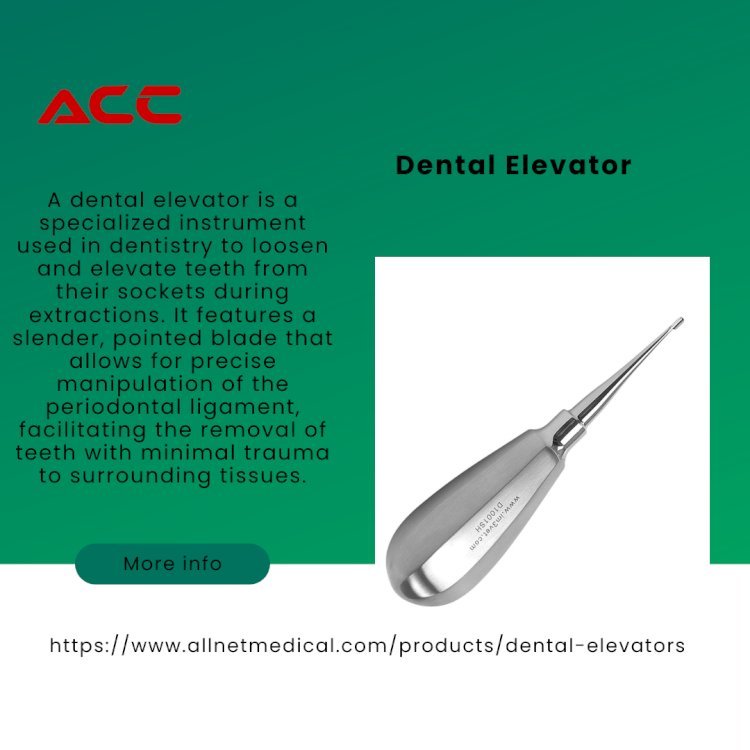The Scope of Versatile Dental Instrument

In modern dentistry, the dental elevator is a highly valuable dental instrument used in various procedures, primarily for tooth extractions. Though its main purpose is to facilitate the removal of teeth, the scope of the dental elevator extends beyond extractions alone. Its functionality, versatility, and ability to reduce trauma make it an indispensable tool in dental practices. This article explores the full scope of the dental elevator and its multiple uses in the field of dentistry.
1. Key Function: Assisting in Tooth Extractions
The most recognized function of a dental elevator is to assist in tooth extractions. Before forceps are used to remove a tooth, the dental elevator is employed to loosen the tooth from its socket by separating it from the surrounding bone and periodontal ligament. This process, known as luxation, makes the extraction smoother and less forceful.
For difficult extractions, such as those involving impacted or partially erupted teeth, the dental elevator is critical in gradually loosening the tooth, reducing the risk of fracturing it or damaging the surrounding bone.
2. Facilitating Complex Extractions
In complex cases, such as the removal of impacted wisdom teeth or roots, the dental elevator plays a vital role. Impacted teeth, which are often stuck beneath the gum line or encased in bone, require delicate handling. The dental elevator provides the leverage needed to ease the tooth from its position.
For surgical extractions that involve broken or fragmented teeth, the dental elevator helps remove roots and fragments by carefully wedging into hard-to-reach areas. It enables the safe removal of fragments while minimizing tissue trauma, making it an essential tool for complex extractions.
3. Supporting Atraumatic Extractions
One of the key advantages of the dental elevator is its contribution to atraumatic extractions. Atraumatic extraction techniques prioritize minimizing damage to the surrounding bone and tissues, which is crucial for procedures like implant placement.
By gently loosening the tooth and using precise movements, the dental elevator helps preserve the bone structure, making it ideal for situations where future dental implants are planned. Luxating elevators, a specialized form of dental elevator, are specifically designed for this purpose and allow dentists to carry out extractions with minimal bone loss.
4. Versatility in Oral Surgery
The scope of the dental elevator extends beyond extractions. In oral surgery, periosteal elevators, a type of dental elevator, are used to lift and reflect soft tissue during surgical procedures such as bone grafting, implant placements, and sinus lifts. By carefully lifting the soft tissue, the surgeon gains access to the underlying bone, ensuring precise and effective surgical work.
This versatility makes dental elevators an essential tool not only for routine extractions but also for advanced oral surgical procedures. Whether elevating soft tissue or assisting in bone surgeries, dental elevators offer precision and control in surgical environments.
5. Root Fragment Removal
In cases where a tooth has fractured or a portion of the root remains in the socket, the dental elevator is invaluable for removing these root fragments. Its design allows for careful and precise removal of fragments without causing additional damage to surrounding tissues.
Root fragment removal is often necessary to prevent infection or future complications. The dental elevator provides the leverage and control needed to ensure that all fragments are successfully removed from the socket.
6. Reducing Patient Trauma
The ability of the dental elevator to minimize trauma is one of its most important benefits. By loosening the tooth or fragment before using forceps, the dentist can reduce the amount of force applied during extraction. This minimizes the risk of damage to surrounding bone and tissue, leading to faster healing and fewer complications post-procedure.
Less trauma also means a more comfortable experience for the patient. By using a dental elevator during extraction, dentists can reduce pain, swelling, and recovery time, which enhances overall patient satisfaction.
7. Enhancing Surgical Efficiency
The dental elevator also enhances the efficiency of dental surgeries by allowing for quicker and more controlled extractions. Its ability to loosen teeth and fragments before forceps are applied means that procedures can be completed faster and with greater precision.
This is especially important during complex surgeries or extractions involving multiple teeth, where the dentist must balance speed with care to minimize the patient’s time under anesthesia. The dental elevator helps streamline the process, improving both the outcome and the overall experience for the patient.
Conclusion
The dental elevator is an essential dental instrument with a broad scope of use in modern dentistry. From its primary role in tooth extractions to its applications in oral surgery, atraumatic extractions, and root fragment removal, the versatility and precision of the dental elevator make it indispensable. Its ability to reduce trauma, preserve bone structure, and enhance surgical efficiency ensures that it will remain a critical tool in dental practices for years to come.
Whether used in routine extractions or complex oral surgeries, the dental elevator plays a fundamental role in improving patient outcomes and advancing dental care.
More info: AllNet
What's Your Reaction?















